Lat/Long: S68°
40.410' W70° 08.279' - Furthest Point South
Wind: NW 12-14kn
Air Temp: -0.8°C Wind Chill: -12.8°C
Surface Water Temp: -1.757°C
Day's menu: Turkey pot pie, baked ham, pencil tip rice, carrots; BBQ Spare ribs, fried fish, rice, cauliflower, salad, pudding, carrot cake and cookies.
» View additional images from today
It was right at this point while on my morning constitutional to the Bridge, that Captain Galster determined it best to turn the ship around and head back north. We had been in grease and pancake ice accompanied by snow squalls for a couple of hours by then, and the growlers were becoming more numerous and troublesome in the reduced vision. We turned just 10 miles from the coast of Alexander Island. I’m sure if it had been clear, it would have been amazing.
I wonder why it is that I can hear the ice along the hull from my cabin’s head (bathroom), but not so much from my bunk, which lies along the hull? It sounds like.. when you drive a car too close to a soft snowbank. Every once in a while, a small growler would get us with a ‘thump’ and someone would call out, "Speedbump!" or "Roadkill!". (Hey, we’re not asking for our own HBO special or anything, just looking for some levity.)
We’ve been looking for the right time of day and condition of ocean to arrange tours of the Engine Room. I was glad when Chief Engineer Paul Waters offered to take the first interested parties early this afternoon. Janis Umschlag and I were in for a real treat!!
Our first stop was the Control Room, where Asst. Engineer Trevor Rafferty was performing an operation to heat the sea water that cools the engine, so it would melt any ice that was in the tank. This has to be done several times a day, more so in the colder waters, of course, as the possibility that the seawater taken in to do the cooling might have ice in it. Trevor sat before a long platform of dials and switches. Paul explained how virtually everything in that engine room that has temperature, pressure, fluid levels, moving parts anything but a human pulse - must be monitored. First, there are a myriad of sensors out there feeding information back to the computers at the Control Panel, each with a separate light and alarm. In addition to that 21st century technology, the engineering team personally checks the engine stem to stern, and documents it several times a day.
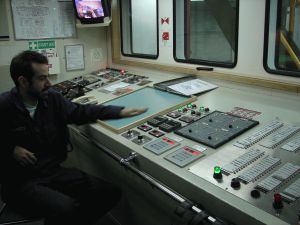
Asst. Engineer Trevor Rafferty in the Engine Control Room (Photo by Janis Umschlag)
|
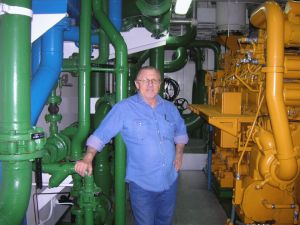
Paul Waters in his gleaming galaxy of pristine pipes.(Photo by Ellen Bailey)
|
At this point, Paul offered us sound dampening earphones for what was to come ahead... (Photo by Ellen Bailey)
He might as well have offered white gloves as well! That engine room, at first sight visible from the Control Room through plexiglas windows, was pristine. We passed through the heavy door into the first chamber of the whole system, and the deep bass noise consumed all other. Although Paul succeeded at times to tell me things in short sentences, I still had to have the earpiece partially covering my ear. But what an education it was!! Many of the large steel vessels (housing moving parts in oil, mostly) were painted and polished white and yellow. These housings are clean so that even the slightest leak of oil could be easily and quickly seen. White Glove Test #1. Other parts, like the water and gasoline purification systems (don’t worry, they’re separate) were shiny steel and blue or yellow respectively, salt water things are green and firefighting compressors and their associated pipes were painted red. Onward. There is a full tooling room with lathes and drills and the biggest set of wrenches you ever saw (Janis mentioned the sensation Alice in Wonderland must have had when she took the pill that made her smaller.) White Glove Test #2 the tool bench. And it didn’t look as if nothing had ever been fixed there, just that everything was cleaned afterward (ed. note: Fred). The next chamber had storage for parts upon parts upon parts. Everything labeled, everything catalogued Paul said they had 2,700 parts in the inventory, and they had to know where they all were - and quickly.
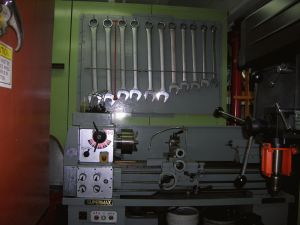
The tool bench area
|
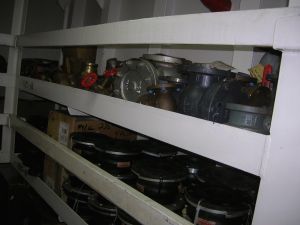
Part of the ‘Parts’ Department. (Photo by Ellen Bailey)
|
There are 40 pumps associated with this operation, and Paul knows how to keep every one of them running. He also knows the importance of teaching those working with him how to change a part or repair a pump, and gives them hands-on training from the start. "No sense knowing something but not wanting to get your hands dirty," is his feeling ("like some of them ‘Academy Boys’ but not Trevor," he qualified. He’s seen Trevor "go in there and get his hands dirty, plenty!"). There are some pretty tight places in this engine system, and Paul is just the right size to work in any of them. This contrasts with Trevor’s oh, 6’4" frame, that might not get into some places as easily, "but he can reach things that are way up on top for me!!" beamed Paul.
Paul showed us the floor hatches leading to the propeller shafts that are the end product of this whole operation. He lifted a hatch, and you could see that steel thing just turning "like butta" a couple of hundred times a minute. This was the small gear shaft the next bigger one, that much closer to the prop itself, turned a little slower, but still, "like butta". And the engine goes "hummmmmmmmmmmmmm". The reverse mechanism is unlike our simple machines at home, where they stop, then turn in the opposite direction. With this, the Variable Pitch Propeller’s shaft always turns in the same direction, but the propeller modifies its pitch to pull the boat in reverse.
The two huge yellow Caterpillar engines are rated for 3300 horsepower each. The ship carries 180-200,000 gallons of diesel fuel to run them, plus oils of different viscosities to lubricate the many moving parts throughout the system. They have more than enough of each for a trip such as ours, when we are out at sea for 35 days without a fuel stop
The Rudder system impressed me the most. It was one large room with two huge white hydraulic units, with parts of the shiny, oiled shaft showing on the two great opposing arms of each. Every so often one or the other of these would shift to a bit longer one side, shorter on the other, then back moving the great steel rudders you could only imagine were there, splayed out below our feet in the cold blue sea. There was a monster wrench on the wall that turns the nut on the top of these units, and it takes 2 men to lift it.
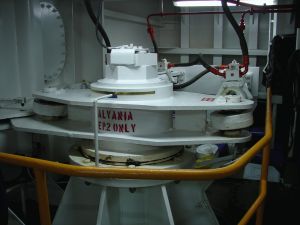
Rudder ‘robot’ (Photo by Janis Umschlag)
|
Getting to Know You
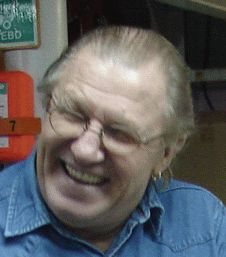
(Photo by Janis Umschlag)
|
Paul Waters, Chief Engineer
Paul was born and lived his
youth in Brevard NC, in the foothills of the Blue Ridge Mountains.
To say he’s made something large of his life based on a very
modest start is an understatement. Altogether there were 13
of them, not all survived, but those who did were raised under
the nurture and sunlight of a strong and understanding mother.
She guided them with a constitution for honesty and trust that
was the foundation for what we can hope will be a long, long
life for Paul.
He left home and took his first real paying job in Florida at the age of 14, and I believe although he had already had a bellyful of life’s lessons, he started (with stops and starts along the way) on the road to what has become, in my mind of who a man is, a huge success. Fortune first struck in 1974 when on his way to a job in California, he was waylaid by a motorcycle breakdown. Hitchhiking on a highway in Louisiana to get parts for repair, he was given a ride by a man who would ultimately make him a better offer and put him on a tugboat to work as an engineer right there in LA. As it turns out, that was his calling and he’s been on boats - big boats - ever since.
In 1993 Paul got his first job with Edison-Chouest, the company that built and owns this ship. He was assigned to the Nathaniel B. Palmer (the big-sister ship we toured in Punta Arenas), where he was an engineer for 3 years. He then spent a year in the waters of Southeast Asia aboard the Margaret, when an engineering opening on the L.M. Gould (this ship) came open. His dedication to the company and to this ship showed clearly in my conversation with Paul. There is not a detail missed, a corner unaccounted for, a moving part not moving smoothly. In our tour of the engine room, Paul was in his bliss. He walked, all 5 foot 7 of him, with a swagger after which - well, if you looked up swagger in the dictionary, there would be a picture of Paul Waters, because he owned every broad step and twist of the torso. This is his baby, the men working with him are encouraged and enlisted to work with the same pride and noble expectations as Paul, and there’s not a captain out there who could come on this ship and not be duly humbled by the man who, along with his able team, keeps this beast hummin’.
Paul’s home with his wife is in Easley, South Carolina, near where most of his family now lives. Although he dedicates about 10 months a year to his EC ship career, he knows it will pay off in retirement when he can be at home in a place that, when he talks about it, brings a sparkle to his eye, and a grin to his friendly face.
Back to the Science
The Plankton Team brought in a very icy net this morning. It was slush, really, that had perhaps been mixed into deeper water by the propellers, then picked up by the net as it approached the ship. That was the downside of the operation. The upside was that this turned out to be the most diverse sampling of any tow so far on this trip! This means they put up more vials (little capped tubes for later viewing) with different kinds of critters in just this one tow than they’d done before. Diversity! One of their finds was a juvenile sea cucumber with a new type of ‘design’ in its calcium carbonate (hard) deposits they were shaped like wagon wheels! Izzy Williams was very excited about this, and if I’m lucky, I can put a microscope picture of it in a later Journal.
The Benthic Team has taken to working very odd hours, and I don’t talk to them any more. Just kidding, but we’ve been steaming most of this day, and the next benthic trawl will be at 3 a.m. (Mamas, don’t let your ba-bies grow up to be Marine Biologists...) This will be Station #44, which means we’ve stopped to perform specimen collections 43 times already!!
back
|
